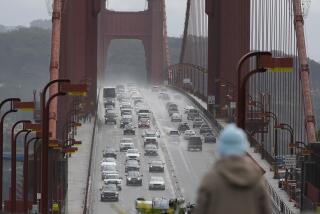U.S. Adopts New Side-Crash Standard : Automobiles: Regulators say 500 lives a year will be saved. A consumer activist thinks that the safety change isn’t tough enough.
- Share via
WASHINGTON — Manufacturers of passenger cars will have to provide more protection from side-door crashes under a new safety standard expected to save 500 lives a year, the Department of Transportation announced Wednesday.
The new safety standard--among the most complicated and significant ever set by the National Highway Traffic Safety Administration--is also expected to prevent about 2,600 injuries annually, Secretary of Transportation Samuel K. Skinner told a news conference on the Capitol lawn.
Side crashes, the second-leading cause of injury and death in automobile accidents, account for 8,000 deaths and 24,000 injuries each year. Automobile makers supported the ruling, which calls for energy-absorbing interior door padding or reinforced side structures to lessen crash impact on passengers.
The new standard, in the form of an amendment to the 1966 Federal Motor Vehicle Safety Standard, is intended to protect passengers from chest and pelvic injuries that occur during side-door collisions.
Skinner described the new regulation as “the most significant improvement in motor vehicle safety since the 1984 requirement for air bags or automatic safety belts.”
However, Joan Claybrook, the president of Public Citizen and a former NHTSA chief, criticized the regulation as a “mini-standard” because it does not protect against head injuries, the most prevalent cause of deaths in side collisions.
After a four-year phase-in scheduled to begin in the fall of 1993, all automobiles sold in the United States must comply with the standard, which will cost an average of $50 per car, including decreased fuel economy.
“The public is becoming so safety-conscious, and safety does sell,” said Chrysler Corp. spokesman John Guiniven, adding that many customers now request cars with air bags. “The public is willing to pay for the cost of added safety features.”
Ford Motor Co. executive Robert H. Munson expressed some negative sentiment over the ruling, saying it may “necessitate significant reengineering of our product lines.” He added that the increased weight from the requirements “will make it more difficult to attain fuel economy standards.”
Current DOT requirements call for the strengthening of side door panels with metal beams. “The existing policy is good, but it’s mainly effective in single vehicle crashes, like if your car hits a telephone pole,” said Barry Felrice, associate administrator for rule making at DOT.
Light trucks and vans are not included in the new rules, said NHTSA administrator Jerry Ralph Curry.
Under the new standard, manufacturers are required to simulate an accident in which an automobile traveling at 30 m.p.h. strikes an automobile traveling at 15 m.p.h--speeds that both industry and agency officials described as compromise numbers.
All cars on the market can meet the new rule, Felrice said.
“A percentage” of automobiles already meet the DOT side impact standards, Curry said, but he refused to say which ones. Barbara Mansfield, a spokesman for Ford, said Ford has “several” models that meet the side impact standard, but also would not name them.






